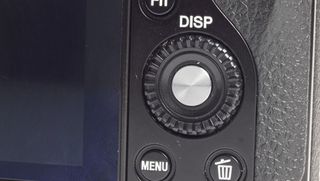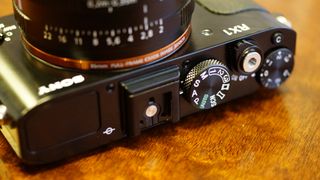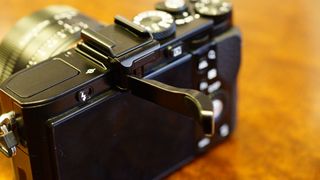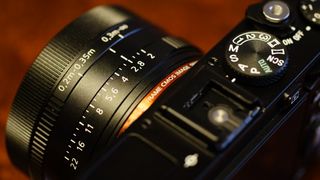Why you can trust TechRadar
Seeing as the Sony RX1 features the same full-frame sensor as the Sony Alpha a99, not to mention the sizable asking price, we had very high hopes for this camera. Happily, we have not been disappointed with image quality.
The camera is capable of producing images with a fantastic amount of detail, with beautiful punchy colours and low noise in high sensitivity situations.
Although it has a 35mm fixed lens, it's worth pointing out that it's a Carl Zeiss optic with T* coatings and an f/2.0 maximum aperture, so what you're getting here is an extremely high quality lens, to match that fantastic sensor. You really do get something that can deliver great results.

Autofocusing speeds are generally quite good - in good light the camera is able to accurately and quickly lock onto a subject. If the light falls, the camera is prone to hunting around for a little longer, but in both good and poor light, it's rare for the camera to confirm focus when it has missed it.
The ring around the lens enables it to focus as close as 20cm when the macro mode is activated. This is a handy addition and does enable you to capture some closer shots, but don't expect to get too close as 1:1 macro isn't possible.
Although the Sony RX1 isn't really a camera designed to be used in fully automatic mode, it nevertheless does a good job of selecting the most appropriate settings if you do choose to put it in this mode.
Most of the automatic settings within the semi-automatic and full manual modes do a good job. For instance, auto white balance does a great job of accurately reproducing colours.
Under indoor artificial light, it has a tendency to err ever so slightly on the warm side, so if this proves a problem, changing to Incandescent mode is recommended.
Similarly, general metering performs pretty well in the majority of conditions. During our testing it had some slight trouble with a very high contrast scene, so switching to spot metering was necessary to gain the correct exposure.

Since images shot at high ISOs are very good - there's a minimal amount of image noise while still retaining a good amount of detail - it makes sense to let the camera decide which ISO setting to use in everyday scenarios, especially since you can set both the maximum and minimum upper limits.
When shooting areas that contain a lot of shadow, you can choose to activate the Dynamic Range Optimiser (DRO) to help pull back detail from these shadowed areas without overexposing the brighter areas.

There are five levels of DRO available, ranging from 1-5, while an Automatic option is available. This does a good job and is a great option if the camera is struggling with a high contrast subject.
Bringing over one of the technologies from its other compact cameras, the Sony RX1 includes Sweep Panorama. This involves moving the camera across a scene to capture an ultra-wide panorama, which the camera then stitches together automatically.
The results from this are pretty good, with very little evidence of the stitching. And while they're probably not high quality enough to make large prints from, they are fine for sharing them online.

Sony, like several other camera manufacturers, is keen to appeal to the Instagram generation, and as such includes a wide variety of digital filters on its cameras. The Sony RX1 has several of these, including Toy Camera, Miniature and Pop Colour.
Sadly, because these can't be shot in raw format, you're stuck with the filter should you change your mind at a later date.
If you want to get creative, but keep the option of having a "clean" file to work with, you can choose one of the Creative Styles, which includes Vivid, Black and White and Landscape. These can also be customised, for instance to increase the contrast, and are a good option for experimenting with.

By far the worst thing about the Sony RX1 is its very poor battery life.
That 35mm fixed focal length should make this an ideal camera to carry around every day, but sadly you won't get very far, with a single charge of the battery barely lasting two hours with moderate use.
For a camera with such a high asking price, it would be nice if Sony included a spare battery in the box as standard, since it's pretty much an essential purchase otherwise.

The screen, which is a 1.2 million dot TFT Xtra Fine device, boasts Sony's "White Magic" technology, which means that it includes an extra white pixel for every RGB pixel.
This is designed to boast contrast, and certainly helps with reducing glare and reflections in all but the very brightest of sunlight.
There's no viewfinder included on the Sony RX1, so unless you choose to purchase the additional extra, you need to rely on the screen to compose your shots.
Amy has been writing about cameras, photography and associated tech since 2009. Amy was once part of the photography testing team for Future Publishing working across TechRadar, Digital Camera, PhotoPlus, N Photo and Photography Week. For her photography, she has won awards and has been exhibited. She often partakes in unusual projects - including one intense year where she used a different camera every single day. Amy is currently the Features Editor at Amateur Photographer magazine, and in her increasingly little spare time works across a number of high-profile publications including Wired, Stuff, Digital Camera World, Expert Reviews, and just a little off-tangent, PetsRadar.


